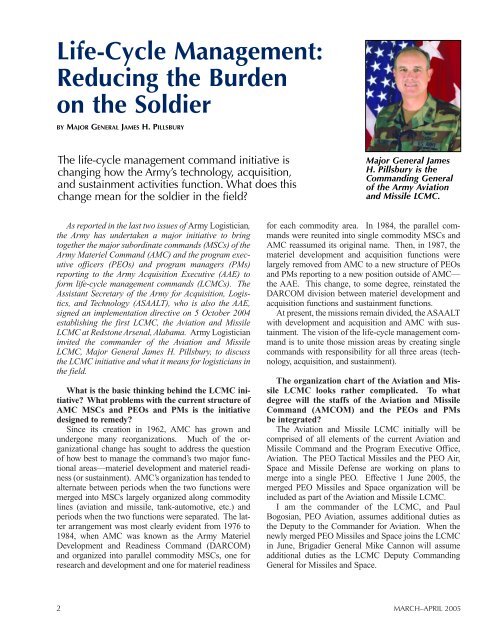Life-Cycle Management - Army Logistics University - U.S. Army
Life-Cycle Management - Army Logistics University - U.S. Army
Life-Cycle Management - Army Logistics University - U.S. Army
You also want an ePaper? Increase the reach of your titles
YUMPU automatically turns print PDFs into web optimized ePapers that Google loves.
<strong>Life</strong>-<strong>Cycle</strong> <strong>Management</strong>:<br />
Reducing the Burden<br />
on the Soldier<br />
BY MAJOR GENERAL JAMES H. PILLSBURY<br />
The life-cycle management command initiative is<br />
changing how the <strong>Army</strong>’s technology, acquisition,<br />
and sustainment activities function. What does this<br />
change mean for the soldier in the field?<br />
As reported in the last two issues of <strong>Army</strong> Logistician,<br />
the <strong>Army</strong> has undertaken a major initiative to bring<br />
together the major subordinate commands (MSCs) of the<br />
<strong>Army</strong> Materiel Command (AMC) and the program executive<br />
officers (PEOs) and program managers (PMs)<br />
reporting to the <strong>Army</strong> Acquisition Executive (AAE) to<br />
form life-cycle management commands (LCMCs). The<br />
Assistant Secretary of the <strong>Army</strong> for Acquisition, <strong>Logistics</strong>,<br />
and Technology (ASAALT), who is also the AAE,<br />
signed an implementation directive on 5 October 2004<br />
establishing the first LCMC, the Aviation and Missile<br />
LCMC at Redstone Arsenal, Alabama. <strong>Army</strong> Logistician<br />
invited the commander of the Aviation and Missile<br />
LCMC, Major General James H. Pillsbury, to discuss<br />
the LCMC initiative and what it means for logisticians in<br />
the field.<br />
What is the basic thinking behind the LCMC initiative?<br />
What problems with the current structure of<br />
AMC MSCs and PEOs and PMs is the initiative<br />
designed to remedy?<br />
Since its creation in 1962, AMC has grown and<br />
undergone many reorganizations. Much of the organizational<br />
change has sought to address the question<br />
of how best to manage the command’s two major functional<br />
areas—materiel development and materiel readiness<br />
(or sustainment). AMC’s organization has tended to<br />
alternate between periods when the two functions were<br />
merged into MSCs largely organized along commodity<br />
lines (aviation and missile, tank-automotive, etc.) and<br />
periods when the two functions were separated. The latter<br />
arrangement was most clearly evident from 1976 to<br />
1984, when AMC was known as the <strong>Army</strong> Materiel<br />
Development and Readiness Command (DARCOM)<br />
and organized into parallel commodity MSCs, one for<br />
research and development and one for materiel readiness<br />
2<br />
Major General James<br />
H. Pillsbury is the<br />
Commanding General<br />
of the <strong>Army</strong> Aviation<br />
and Missile LCMC.<br />
for each commodity area. In 1984, the parallel commands<br />
were reunited into single commodity MSCs and<br />
AMC reassumed its original name. Then, in 1987, the<br />
materiel development and acquisition functions were<br />
largely removed from AMC to a new structure of PEOs<br />
and PMs reporting to a new position outside of AMC—<br />
the AAE. This change, to some degree, reinstated the<br />
DARCOM division between materiel development and<br />
acquisition functions and sustainment functions.<br />
At present, the missions remain divided, the ASAALT<br />
with development and acquisition and AMC with sustainment.<br />
The vision of the life-cycle management command<br />
is to unite those mission areas by creating single<br />
commands with responsibility for all three areas (technology,<br />
acquisition, and sustainment).<br />
The organization chart of the Aviation and Missile<br />
LCMC looks rather complicated. To what<br />
degree will the staffs of the Aviation and Missile<br />
Command (AMCOM) and the PEOs and PMs<br />
be integrated?<br />
The Aviation and Missile LCMC initially will be<br />
comprised of all elements of the current Aviation and<br />
Missile Command and the Program Executive Office,<br />
Aviation. The PEO Tactical Missiles and the PEO Air,<br />
Space and Missile Defense are working on plans to<br />
merge into a single PEO. Effective 1 June 2005, the<br />
merged PEO Missiles and Space organization will be<br />
included as part of the Aviation and Missile LCMC.<br />
I am the commander of the LCMC, and Paul<br />
Bogosian, PEO Aviation, assumes additional duties as<br />
the Deputy to the Commander for Aviation. When the<br />
newly merged PEO Missiles and Space joins the LCMC<br />
in June, Brigadier General Mike Cannon will assume<br />
additional duties as the LCMC Deputy Commanding<br />
General for Missiles and Space.<br />
MARCH–APRIL 2005







